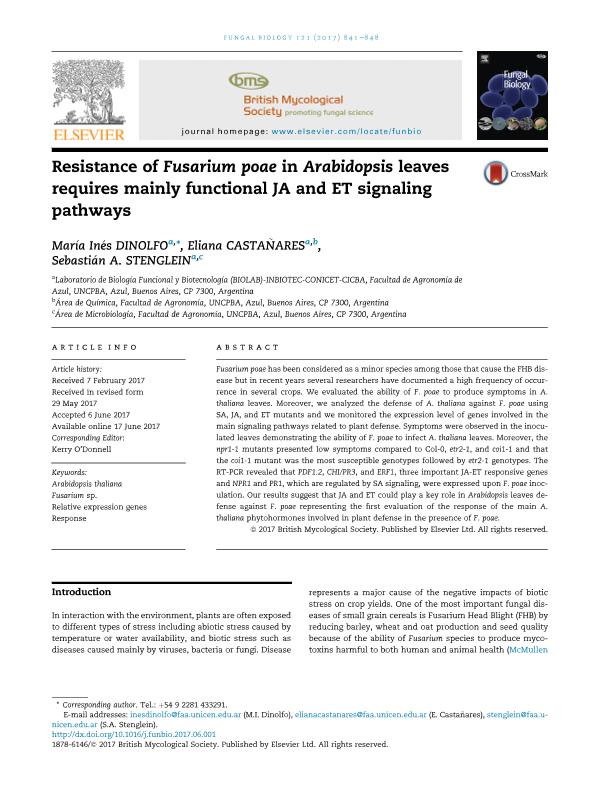Mostrar el registro sencillo del ítem
dc.contributor.author
Dinolfo, María Inés

dc.contributor.author
Castañares, Eliana

dc.contributor.author
Stenglein, Sebastian Alberto

dc.date.available
2018-08-15T19:20:38Z
dc.date.issued
2017-10
dc.identifier.citation
Dinolfo, María Inés; Castañares, Eliana; Stenglein, Sebastian Alberto; Resistance of Fusarium poae in Arabidopsis leaves requires mainly functional JA and ET signaling pathways; Elsevier; Fungal Biology; 121; 10; 10-2017; 841-848
dc.identifier.issn
1878-6146
dc.identifier.uri
http://hdl.handle.net/11336/55714
dc.description.abstract
Fusarium poae has been considered as a minor species among those that cause the FHB disease but in recent years several researchers have documented a high frequency of occurrence in several crops. We evaluated the ability of F. poae to produce symptoms in A. thaliana leaves. Moreover, we analyzed the defense of A. thaliana against F. poae using SA, JA, and ET mutants and we monitored the expression level of genes involved in the main signaling pathways related to plant defense. Symptoms were observed in the inoculated leaves demonstrating the ability of F. poae to infect A. thaliana leaves. Moreover, the npr1-1 mutants presented low symptoms compared to Col-0, etr2-1, and coi1-1 and that the coi1-1 mutant was the most susceptible genotypes followed by etr2-1 genotypes. The RT-PCR revealed that PDF1.2, CHI/PR3, and ERF1, three important JA-ET responsive genes and NPR1 and PR1, which are regulated by SA signaling, were expressed upon F. poae inoculation. Our results suggest that JA and ET could play a key role in Arabidopsis leaves defense against F. poae representing the first evaluation of the response of the main A. thaliana phytohormones involved in plant defense in the presence of F. poae.
dc.format
application/pdf
dc.language.iso
eng
dc.publisher
Elsevier

dc.rights
info:eu-repo/semantics/openAccess
dc.rights.uri
https://creativecommons.org/licenses/by-nc-nd/2.5/ar/
dc.subject
Arabidopsis Thaliana
dc.subject
Fusarium Sp.
dc.subject
Relative Expression Genes
dc.subject
Response
dc.subject.classification
Agricultura

dc.subject.classification
Agricultura, Silvicultura y Pesca

dc.subject.classification
CIENCIAS AGRÍCOLAS

dc.subject.classification
Otras Biotecnología Agropecuaria

dc.subject.classification
Biotecnología Agropecuaria

dc.subject.classification
CIENCIAS AGRÍCOLAS

dc.subject.classification
Otras Ciencias Biológicas

dc.subject.classification
Ciencias Biológicas

dc.subject.classification
CIENCIAS NATURALES Y EXACTAS

dc.title
Resistance of Fusarium poae in Arabidopsis leaves requires mainly functional JA and ET signaling pathways
dc.type
info:eu-repo/semantics/article
dc.type
info:ar-repo/semantics/artículo
dc.type
info:eu-repo/semantics/publishedVersion
dc.date.updated
2018-08-13T17:24:16Z
dc.journal.volume
121
dc.journal.number
10
dc.journal.pagination
841-848
dc.journal.pais
Países Bajos

dc.description.fil
Fil: Dinolfo, María Inés. Consejo Nacional de Investigaciones Científicas y Técnicas. Centro Cientifico Tecnolológico Mar del Plata. Instituto de Investigaciones en Biodiversidad y Biotecnología. Laboratorio de Biología Funcional y Biotecnología; Argentina
dc.description.fil
Fil: Castañares, Eliana. Consejo Nacional de Investigaciones Científicas y Técnicas. Centro Cientifico Tecnolológico Mar del Plata. Instituto de Investigaciones en Biodiversidad y Biotecnología. Laboratorio de Biología Funcional y Biotecnología; Argentina
dc.description.fil
Fil: Stenglein, Sebastian Alberto. Consejo Nacional de Investigaciones Científicas y Técnicas. Centro Cientifico Tecnolológico Mar del Plata. Instituto de Investigaciones en Biodiversidad y Biotecnología. Laboratorio de Biología Funcional y Biotecnología; Argentina
dc.journal.title
Fungal Biology
dc.relation.alternativeid
info:eu-repo/semantics/altIdentifier/url/https://www.sciencedirect.com/science/article/pii/S1878614617300697
dc.relation.alternativeid
info:eu-repo/semantics/altIdentifier/doi/http://dx.doi.org/10.1016/j.funbio.2017.06.001
Archivos asociados
